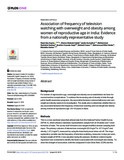Association of frequency of television watching with overweight and obesity among women of reproductive age in India: Evidence from a nationally representative study
Date
2019-08-29Publisher
PLOS ONEAuthor
Gupta, Rajat DasHaider, Shams Shabab
Sutradhar, Ipsita
Hashan, Mohammad Rashidul
Sajal, Ibrahim Hossain
Hasan, Mehedi
Haider, Mohammad Rifat
Sarker, Malabika
Metadata
Show full item recordCitation
Das Gupta, R., Haider, S. S., Sutradhar, I., Hashan, M. R., Sajal, I. H., Hasan, M., Haider, M. R., & Sarker, M. (2019). Association of frequency of television watching with overweight and obesity among women of reproductive age in India: Evidence from a nationally representative study. PloS one, 14(8), e0221758. https://doi.org/10.1371/journal.pone.0221758Abstract
Background
For women of reproductive age, overweight and obesity are an established risk factor for several medical complications. To address the increasing rate of obesity in India through public health awareness programs, the association between common behaviors and overweight and obesity needs to be investigated. This study aims to determine whether there is any association between the frequency of television watching and overweight and obesity among women of reproductive age (15–49 years) in India.
Methods
This is a cross-sectional study that utilized data from the National Family Health Survey (NFHS-4), which utilized a nationally representative sample from all 29 states and 7 union territories of India. The survey itself followed a two-staged stratified random sampling technique. The primary outcome of interest was overweight (23.0 kg/m2 to <27.5 kg/m2) and obesity (≥27.5 kg/m2), measured by using the Asian body mass index cut-off. The major explanatory variable was the frequency of television watching, measured in days per week. Sample weight of NFHS-4 was adjusted during the analysis. Multilevel ordered logistic regression was conducted to identify the factors associated with overweight and obesity. To show the strength of association, both the unadjusted Crude Odds Ratio (COR) and the Adjusted Odds Ratio (AOR) were reported with a 95% confidence interval (CI). A p-value<0.05 was considered statistically significant.
Results
The analysis included weighted data from 644,006 Indian women of reproductive age (15–49 years). Among the respondents, 33.5% were overweight or obese (BMI ≥23.0 kg/m2). The prevalence of overweight and obesity increased with age (p-value <0.0001) and almost half of the women aged 35–49 years were either overweight or obese (48.6%). The prevalence was significantly higher among those living in an urban area compared to a rural area (urban 46.5% vs. rural 26.5%; p-value <0.001). The prevalence of overweight and obesity increased with the frequency of watching television and was the highest among the individuals who reported watching television almost every day (p-value <0.0001). Women watching television almost every day had 24% (AOR: 1.24, 95% CI: 1.21–1.26; p-value <0.001) increased odds of being overweight and obese compared to their counterparts who never watched television.
Conclusions
This study found that the likelihood of being overweight and obese significantly increased with the frequency of watching television; likely due to physical inactivity during leisure time. Further studies should examine the physical activity and food habits of this target group. Public health promotion programs in India should raise awareness regarding the harmful effects of the sedentary lifestyle associated with watching television.

